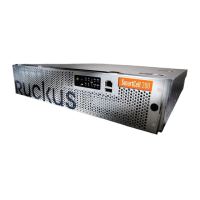2
Managing Ruckus Wireless AP Zones
In this chapter:
• Working with AP Zones
• Working with AP Groups
• Working with AAA Servers
• Working with Hotspot (WISPr) Portals
• Working with Guest Access Portals
• Working with Web Authentication Portals
• Working with Hotspot 2.0 Services
• Working with WLANs and WLAN Groups
• Working with WLAN Schedules
• Working with Device Policies
• Working with L2 Access Control Policies
• Working with Bonjour Policies
• Creating a DiffServ Profile
• Creating an Ethernet Port Profile
• Working With Dynamic PSKs
An AP zone functions as a way of grouping Ruckus Wireless APs and applying a particular set of
settings (including WLANs and their settings) to thise group of Ruckus Wireless APs. Each AP zone
can include up to 27 WLAN services.
Working with AP Zones
By default, an AP zone named Staging Zone exists. Any AP that registers with the controller that
is not assigned a specific zone is automatically assigned to the Staging Zone. This section
describes how to use AP zones to manage devices.
NOTE: When an AP is assigned or moved to the Staging Zone, the cluster name becomes its
user name and password after the AP shows up-to-date state. If you need to log on to the AP,
use the cluster name for the user name and password.
Before creating an AP zone, Ruckus Wireless recommends that you first set the default country
code on the Global Configuration page. This will help ensure that each new AP zone will use
the correct country code. For information on how to set the default country code, see Managing
Global Configuration on page 101.
Using the Domain Tree
Use the domain tree to find APs that you want to manage.
Clicking Configuration > AP Zones on the main menu displays a sidebar on the left side of the
page, which includes the domain tree.
SmartCell Gateway 200/Virtual SmartZone High-Scale for Release 3.4.1 Administrator Guide
31
31

